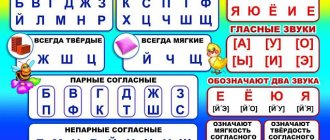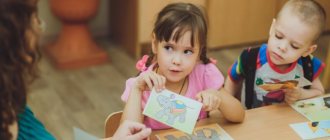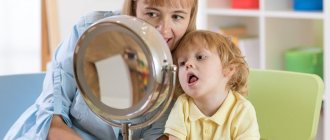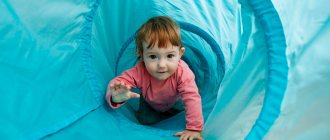Notes of speech therapy classes.
III. Summing up the lesson.
Progress of the lesson.
I. Organizational moment.
Psycho-gymnastics. -Guys, good morning! A new wonderful day has arrived. Now I will smile at you, and you will smile at me and smile at each other. It's so good that we are here with you today. We are calm and kind, we are friendly and affectionate! We are all healthy! Please take a deep breath through your nose. Imagine that you are breathing in the freshness, kindness, and beauty of today! Now exhale. Inhale again and exhale. And the last time, inhale and exhale. Well done! Let's smile at each other again and begin our lesson. - Guys, what date is today? What month? What about the time of year? Why did you decide so? What time of day? Let's write today's date in our notebook.
II. Main part.
1.Message about the topic of the lesson.
-Guys, please guess my riddles.
They made it out of boards and put on a belt. And these dishes store the summer collected from the garden. (barrel)
On the branches - a dense lump. A green leaf sleeps in it. (bud)
- Guys, did you guess what it is? That's right, it's a barrel and a kidney! -What sounds differ between these words? -What sounds are these? (consonants, hard, paired according to deafness - voicedness.). -Let's compare the pronunciation of the sound [b] and the sound [p], what are the similarities and differences in the pronunciation of these sounds (control of the articulation of isolated sounds).
-The following riddles:
We always walk together, looking alike like brothers. We are under the table at dinner, and under the bed at night. (boots)
In winter it doesn’t get warmer, in summer it doesn’t get colder. (cellar)
-Name the first letters in these words.
2. -Guys, now I will list you the fairy-tale characters, and you listen carefully and remember what fairy tale they are from. Pinocchio, Karabas-Barabas, dad Carlo, cat Basilio, Giuseppe. What is this fairy tale? (these are characters from the fairy tale “The Golden Key, or the Adventure of Pinocchio.” Attention is focused on the fact that all the names of fairy-tale characters contain the sounds [b] and [p]). -And now you have this task: please list the fairy tales whose names contain the sounds [b] and [p]. (gingerbread man, turnip, Ryaba chicken, Bremen musicians, bluebeard, swineherd, princess and the pea, Aladdin's magic lamp, Ali Baba and the forty thieves, Elena the Beautiful, etc.) -Where are our sounds in these words? -Guys, now please list the fairy-tale characters whose names contain the sounds [b] and [p]. (Cheburashka, Baba Yaga, Troubadour, Winnie the Pooh, Barmaley, Aibolit, Turtilla Tartilla, Piglet Chok, etc.) -And where are the sounds [b] and [p] in these words? -And in which fairy tale do we meet such characters: Yagupop, Abazh? ( Kingdom of Crooked Mirrors). -What letters in writing represent the sounds [b – p]? (letters “b – p”). -Let's write down some of these words in a notebook in two columns: in the first, words with the sound [b], in the second, words with the sound [p].
| [b] | [P] |
| Kolobok | Princess |
| Barmaley | Swineherd |
| Pinocchio | Winnie the Pooh |
| Cheburashka | Pig Chock |
| Troubadour | Elena the beautiful |
-Please, guys, underline the letter “p” with one line, and the letter “b” with two lines.
3. Physical exercise.
Imitation of the movements of various fairy-tale characters. (How Kolobok rolls. How Pinocchio sticks his long nose everywhere. How the princess walks. How Winnie the Pooh climbs a tree for honey. etc.)
4. Games with sounds [b – p]. “Catch the sound [p] or sound [b]”
-Guys, you should clap your hands once if you hear the sound [p] and twice if you hear the sound [b].
Listen carefully! (lamp, shelf, paper, finger, luggage, album, crowd, dog, ballet, ballet, shovel, fur coat, stick, barrel, kidney, sail, trap, drum, etc.) “Digital series”
- And now you count how many [b] sounds there are in words and raise the corresponding number (1 or 2).
(battle, balalaika, beavers, bomb, blizzard, barberry, armor, drummer, etc.) -Now count the sound [p] in the words and raise the corresponding number. (dad, ensign, saw, Panama, baby, attempt, trap, slippers, etc.) Vocabulary dictation with sounds [b - p].
-Write in three columns: in the first - only with the sound [p], in the second - only with the sound [b], and in the third - with the sounds [b - p].
Underline P with one line, B with two lines. (seal, pirate, sample, lamp, letter, sausage, clouds, clearing, threshold, ram, deck, steamship, barge, fence, bus, cathedral, shelf, marriage, package, parting, device, etc.) Syllabic mosaic
-Now I will give you cards, the syllables “pa” or “ba” are missing in them.
You need to insert these syllables correctly and write down the resulting words. (ry__, tru__, tro__, Liu__, __ran, __latka, __lets, lo__ta, pri__vil, za__va, __gazh, __nan, __rta, __latka, ry__lka, etc.) The letter got lost.
-Replace the voiced [b] with the voiceless [p] and vice versa, the voiceless [p] with the voiced [b]. (stick, kidney, sing, beam, fight, barrel, tale, punk, bank, dust, shine, punk, splash, bank, fence, steam, constipation, bar, space, sang)
III. Summarizing.
-What sounds did we repeat today? -What sounds are used to indicate them when writing? -How are they similar? How are they different? Assessment of children's activities.
Homework.
- Guys, now please write down your homework. Come up with and write down in your notebook the names of birds and animals that contain the sounds [b - p]. Underline “p” with one line, “b” with two lines. (panda, hippopotamus, dog, rooster, sparrow, pigeon, badger, squirrel, parrot, ram, leopard, monkey, etc.)
References: 1. Gaidina L.I., Obukhova L.A. Speech therapy exercises. 1-4 grades. M., 2007. 2. Eletskaya O.V., Gorbachevskaya N.Yu. Organization of speech therapy work at school. M., 2007. 3. Elkina N.V., Tarabarina T.I. 1000 riddles. Yaroslavl, 2002. 4.Efimenkova L.N., Misarenko G.G., Organization and methods of correctional work of a speech therapist at a school speech center. M., 1996. 5. Illarionova Yu.G. Teach children to solve riddles. M., 1985. 6. Lalaeva R.I., Venediktova L.V. Differential diagnosis and correction of reading and writing disorders in primary schoolchildren. SSPb., 1997. 7. Pozhilenko E.A. A magical world of sounds and words. St. Petersburg, 2008.
Good luck!
1. In the game, teach your child to recognize animals and birds by their voices.
2. In the game, learn to imitate the voices of animals and birds.
3. Teach auditory-pronunciation differentiation of sounds: [B] - [P], [B'] - [P'] (differentiation of voiced and voiceless, hard and soft consonant sounds).
4. Continue to teach syllabic analysis and synthesis of words without a combination of consonants.
5. Learn to make sentences using reference words.
6. Learn to analyze and compare words.
7. Strengthen the child’s knowledge of basic spelling rules (working with sentences).
Task 1. Didactic exercises “Collective farm yard”, “In the forest” (development of auditory attention).
An adult imitates the voices of domestic and wild animals and birds (for example, “cuckoo” - cuckoo, “meow” - cat), and the child guesses whose voice it is.
Task 2. Didactic exercises “Collective farm yard”, “In the forest”. Similar to task 1, but the child himself imitates the voices of animals and birds, and the adult guesses whose voice it is.
Task 3. Differentiation of sounds [B] - [P].
Name the first identical sound in the words: loaf, bun, bagel...
Name the same last sound in the words: soup, sheepskin coat...
Compare the articulation of the sounds [P] and [B] (find the commonality and difference, paying attention to the “work of the neck”); remember the characteristic
sounds [P] and [B], designation.
Didactic exercise “Clap your hands if you hear the sound [P]”:
p, b, b, p...; ba, pa, po, bu...; Borya, bots, dad, grandma, dad, grandma...
Didactic exercise “Say the opposite”: pa-ba, ba...; boo-poo..., poo-...
Repeat after the adult a series of syllables:
pa-ba-ba, ba-pa-pa, pa-ba-pa, ba-pa-ba, ba-ba-pa, pa-pa-ba...
Didactic exercise “Make a word from syllables”:
pa-ro-hod, ba-ra-ban, pa-ra-shute, boo-zi-na.
Didactic exercise “Divide the word into syllables” (the adult invites the child to pronounce the word syllable by syllable, clapping his hands for each spoken syllable). Think about which word is the longest?
Tomatoes, dad, granny, gift, beads, paper.
Name the extra word in the series (based on the presence of sounds [P] and [B]):
jar, panama, sandwich, bottle; peacock, button, stick, ram.
Task 4 Choose from a number of drawn objects with the sound [B] ([P]) in their names.
Find words with sounds [P] and [B].
Remember the riddles for the sounds [P] and [B] (see topics No. 12, 13).
Task 5 An adult invites the child to replace the sound [P] with the sound [B] in words. What words did you get?
Kidney - barrel, steam - ..., sweat - ..., sing - ..., dad - ..., arable land - ..., pass - ..., right - ..., stick - ...
Task 6. Differentiation of sounds [B'] - [P'].
Name the first sound in the words: hippopotamus, squirrel, bison ([B']).
Name the first sound in the words: Petya, first, saw ([P']).
Compare the articulation of the sounds [P'] and [B'], paying attention to the “work of the neck”, remember the characteristic
and designation of sounds.
Didactic exercise “Clap your hands if you hear the sound [B']”:
beat, drink, drink, beat...; five, bya, bi, pi...; birch, squirrel, write...
Didactic exercise “Say the opposite”:
pi-bya, pi-...; beep, beep...
Repeat after the adult a number of syllables:
beep, beep, beep, beep, beep, beep, beep, beep, beep, beep.
Task 7 Remove the extra one from a series of pictures (based on the presence of sounds [B'] and [P'] in the words; the adult does not name the pictures
squirrel, birch, rooster, hippopotamus...
Remember the riddles for the sounds [B'] and [P']. (see topics No. 12, 13).
Remember words with sounds [B'] and [P']. determine the place of sounds in these words (if it is difficult, use a card and green circles with and without a bell).
The adult offers the child to replace the sound [P']. to the sound [B'] in a word. What new word did you get?
Make up sentences with these words.
Drink - …
Task 8. Differentiation of sounds [B] - [P], [B'] - [P'].
Name voiced and voiceless consonant sounds; name hard and soft consonant sounds.
The adult names the word, and the child raises the corresponding letter from this word (B - P).
Learn tongue twisters.
Bull, blunt-lipped, blunt-lipped bull.
The bull's white lip was blunt.
Task 9. Sound-syllable analysis of the words baba, dad (laying out patterns of words from circles, comparing the sound composition of words, finding commonalities and differences in the patterns).
Laying out words from the letters of the cut alphabet. An adult asks the child a question: “What letters need to be replaced in the word dad to turn the word dad into the word baba!”
Reading, copying words, sentences:
Dad is here. There's a woman here.
Compiling sentences based on supporting words (draw the child’s attention to the order of words in a sentence and coordination of sentence members): woman, knit, socks; wood, dad, chop.



